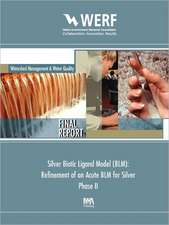Detergents: The Handbook of Environmental Chemistry, cartea 3 / 3F
Editat de N.T. de Oude Contribuţii de F. Balk, J.G. Batelaan, J.G. Blumberg, R.S. Boethling, L. Butterwick, P. Christophliemk, J.S. Falcone, T. Feijtel, P. Gerike, H.L. Gewanter, P.A. Gilbert, C.G.van Ginkel, W.E. Gledhill, D. Gleisberg, J.L. Hamelink, M.S. Holt, H.L. Hoyt, H.B. Kramer, D.G. Lynch, G.C. Mitchell, H.-J. Opgenorth, H.A. Painter, M. Potokar, K. Raymond, R.J. Watkinsonen Limba Engleză Paperback – 20 noi 2013
Din seria The Handbook of Environmental Chemistry
- 18%
 Preț: 1819.46 lei
Preț: 1819.46 lei - 18%
 Preț: 1827.32 lei
Preț: 1827.32 lei - 18%
 Preț: 2102.76 lei
Preț: 2102.76 lei - 18%
 Preț: 2089.35 lei
Preț: 2089.35 lei - 18%
 Preț: 2481.57 lei
Preț: 2481.57 lei - 18%
 Preț: 1223.43 lei
Preț: 1223.43 lei - 5%
 Preț: 1419.56 lei
Preț: 1419.56 lei - 15%
 Preț: 639.41 lei
Preț: 639.41 lei -
 Preț: 392.97 lei
Preț: 392.97 lei - 5%
 Preț: 366.56 lei
Preț: 366.56 lei - 18%
 Preț: 1826.69 lei
Preț: 1826.69 lei - 15%
 Preț: 640.71 lei
Preț: 640.71 lei - 18%
 Preț: 728.91 lei
Preț: 728.91 lei - 5%
 Preț: 1424.89 lei
Preț: 1424.89 lei - 18%
 Preț: 1225.94 lei
Preț: 1225.94 lei -
 Preț: 386.00 lei
Preț: 386.00 lei - 15%
 Preț: 641.53 lei
Preț: 641.53 lei - 5%
 Preț: 1416.81 lei
Preț: 1416.81 lei - 15%
 Preț: 644.82 lei
Preț: 644.82 lei - 5%
 Preț: 1421.76 lei
Preț: 1421.76 lei -
 Preț: 386.39 lei
Preț: 386.39 lei -
 Preț: 389.49 lei
Preț: 389.49 lei - 5%
 Preț: 719.02 lei
Preț: 719.02 lei - 5%
 Preț: 714.63 lei
Preț: 714.63 lei - 18%
 Preț: 1215.22 lei
Preț: 1215.22 lei -
 Preț: 392.97 lei
Preț: 392.97 lei - 18%
 Preț: 1832.08 lei
Preț: 1832.08 lei - 15%
 Preț: 639.73 lei
Preț: 639.73 lei - 5%
 Preț: 1925.56 lei
Preț: 1925.56 lei -
 Preț: 381.98 lei
Preț: 381.98 lei - 5%
 Preț: 363.97 lei
Preț: 363.97 lei -
 Preț: 386.00 lei
Preț: 386.00 lei - 5%
 Preț: 1423.39 lei
Preț: 1423.39 lei - 15%
 Preț: 643.16 lei
Preț: 643.16 lei -
 Preț: 383.12 lei
Preț: 383.12 lei - 15%
 Preț: 642.51 lei
Preț: 642.51 lei - 5%
 Preț: 716.09 lei
Preț: 716.09 lei - 5%
 Preț: 1407.87 lei
Preț: 1407.87 lei - 18%
 Preț: 1231.01 lei
Preț: 1231.01 lei
Preț: 732.70 lei
Preț vechi: 893.54 lei
-18% Nou
Puncte Express: 1099
Preț estimativ în valută:
140.25€ • 152.39$ • 117.88£
140.25€ • 152.39$ • 117.88£
Carte tipărită la comandă
Livrare economică 21 aprilie-05 mai
Preluare comenzi: 021 569.72.76
Specificații
ISBN-13: 9783662149836
ISBN-10: 3662149834
Pagini: 424
Ilustrații: XV, 406 p. 12 illus. in color.
Dimensiuni: 155 x 235 x 22 mm
Greutate: 0.59 kg
Ediția:Softcover reprint of the original 1st ed. 1992
Editura: Springer Berlin, Heidelberg
Colecția Springer
Seriile The Handbook of Environmental Chemistry, Anthropogenic Compounds
Locul publicării:Berlin, Heidelberg, Germany
ISBN-10: 3662149834
Pagini: 424
Ilustrații: XV, 406 p. 12 illus. in color.
Dimensiuni: 155 x 235 x 22 mm
Greutate: 0.59 kg
Ediția:Softcover reprint of the original 1st ed. 1992
Editura: Springer Berlin, Heidelberg
Colecția Springer
Seriile The Handbook of Environmental Chemistry, Anthropogenic Compounds
Locul publicării:Berlin, Heidelberg, Germany
Public țintă
ResearchCuprins
Anionic Surfactants.- The Environmental Chemistry, Fate and Effects of Nonionic Surfactants.- Quaternary Ammonium Surfactants.- Phosphate.- Zeolites.- Citrate.- EDTA—Ethylenediaminetetraacetic Acid.- Environmental Properties and Safety Assessment of Organic Phosphonates Used for Detergent and Water Treatment Applications.- Perborate.- TAED—Tetraacetylethylenediamine.- Carboxymethylcellulose (CMC).- Polymeric Materials, Polycarboxylates.- Fluorescent Whitening Agents.- Anthropogenic Silicates.- Silicones.
















